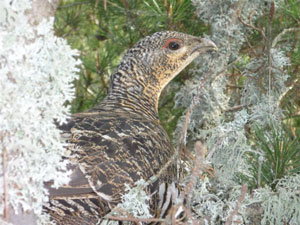Magazine | Analyses
La détresse sexuelle d’une femelle de Grand Tétras en Lozère

Grand Tétras (Tetrao urogallus) femelle au comportement déviant, en « détresse sexuelle », lac de Charpal (Lozère), mai 2011.
Photographie : Stéphane Faudon
Introduction
Le Grand Tétras (Tetrao urogallus) est un grand gallinacé discret, évitant l’Homme et vivant en Europe dans les forêts mixtes de montagne et dans la taïga. Mais l’on rencontre parfois des oiseaux au comportement aberrant : ce sont souvent des mâles particulièrement agressifs ou trop confiants, mais aussi parfois des poules particulièrement « entreprenantes » qui se mettent en position d’accouplement devant les passants.
Le 9 mai 2011, une femelle a suivi un long moment Stéphane Faudon, un guide de pêche qui accompagnait des clients sur les rives du lac de Charpal, non loin de Mende, en Lozère. Elle venait parfois tout près des pieds des participants et s’accroupissait la tête baissée et les ailes frémissantes…
Nous remercions Christian Nappée et Stéphane Faudon pour leurs informations et leurs photos.
Abstract
The Western Capercaillie (Tetrao urogallus) is the largest member of the grouse family, reaching over 100 cm in length and 6.7 kg in weight. It is a sedentary species, breeding across northern parts of Europe and western and central Asia in mature conifer forests with diverse species composition and a relatively open canopy structure.
It is a shy species, sensitive towards disturbances. The average escape distance is about 30 to 150 metres. However, some birds do not escape but on the contrary come closer towards people. The frequency, behavior, and testosterone levels of deviant capercaillies were studied in southern Finland. Roughly 1% of the population was estimated to behave abnormally. Deviant males display and show threatening behavior toward not only humans, but also attacked stuffed capercaillie males and without hesitation copulated with a stuffed female. Deviant females appear tame and crouch in front of humans.
In May 2011, such a female was found by Stéphane Faudon near the lake of Charpal (Lozère, France) and then captured and released in an area with several males.
Poursuivez la lecture de cet article, en vous abonnant dès maintenant !
Découvrez les Archives d’Ornithomedia.com
Pour seulement 10,00 €TTC/an (ou 6,00 € les 6 mois)
Profitez de plusieurs centaines d’articles en accès illimité et sans aucun engagement.
Compléments
ontact
Christian NAPPEE : christian.nappeeATwanadoo.fr (remplacez « AT » par @)
À lire sur le web
Le Grand Tétras dans les Cévennes, une réintroduction difficile. Ornithos 15-4. http://www.groupe-tetras-jura.org/IMG/pdf/282-293_Gd_Tetras_Cevennes.pdf
Ouvrages recommandés
- Le guide Ornitho Killian Mullarney
- Lozère de Dominique Auzias et al.
Sources
- Christian Nappée. Le Grand Tétras dans les Cévennes : histoire d’une réintroduction difficile. WPA-France. Bulletin numéro 50. http://wpa-france-galliformes.fr/grand_tetras.html
- M. Milonoff, R. Hissa et B. Silverin (). The abnormal conduct of capercaillies Tetrao urogallus. Hormones and Behavior Volume 26, Issue 4, Decembre 1992, Pages 556-567. http://www.sciencedirect.com/science/article/pii/0018506X9290022N





Aucun commentaire sur ce sujet
Participer à la discussion !